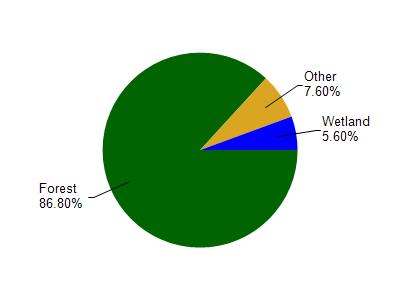Bayfield
No
No
No
Fish and Aquatic Life
Overview
This stream is considered a Class II trout fishery in its lower reaches. An intermittent feeder stream drains lands that were formerly the site of the E.I. du Pont de Nemours Barksdale Works, a 1,500-acre explosives plant. Areas of the site where sulfuric and nitric acid were used and burned, and the transport and possible storage of hazardous materials occurred near the headwaters of the intermittent drainage to Bono Creek. Many acres of the site continue to show unvegetated scarring. Several ponds on the site appear to have been one-time settling ponds. They connect by a water-filled ditch and wetland to drainage that may enter Bono Creek, Boyd Creek or unnamed streams that flow directly to Lake Superior. It is unclear whether contaminants still exist in these ponds, or whether any settled sludges have been removed. See the description of Boyd Creek for more information on this site.
During survey work conducted as part of the coastal wetlands evaluation, no rare species of macroinvertebrates were found and overall taxa richness was moderate (5-24 species) (Epstein 1997). The survey noted that potential pollutant sources include livestock, barnyards and cropland and impoundment may impede habitat quality. Data collected in 1996 near the Bjork Road crossing about one mile upstream from the mouth and near the former du Pont plant measured pH in the stream at 8.9, which is very alkaline and at a much higher level than other streams evaluated in this part of the Bayfield Peninsula. Methyl purple alkalinity at this site was measured at 243, which is considered hard. This, along with a conductivity of 438 may indicate some impact from the du Pont site.
Date 1999
Author Aquatic Biologist
Condition
Wisconsin has over 84,000 miles of streams, 15,000 lakes and milllions of acres of wetlands. Assessing the condition of this vast amount of water is challenging. The state's water monitoring program uses a media-based, cross-program approach to analyze water condition. An updated monitoring strategy (2015-2020) is now available. Compliance with Clean Water Act fishable, swimmable standards are located in the Executive Summary of Water Condition in 2018. See also the 'monitoring and projects' tab.
Reports
Recommendations
Monitor Water Quality or Sediment
Category 3. 2018 TP Results: May Exceed. Station: 10044244. AU: 17603.
Management Goals
Wisconsin's Water Quality Standards provide qualitative and quantitative goals for waters that are protective of Fishable, Swimmable conditions [Learn more]. Waters that do not meet water quality standards are considered impaired and restoration actions are planned and carried out until the water is once again fishable and swimmable
Management goals can include creation or implementation of a Total Maximum Daily Load analysis, a Nine Key Element Plan, or other restoration work, education and outreach and more. If specific recommendations exist for this water, they will be displayed below online.
Monitoring
Monitoring the condition of a river, stream, or lake includes gathering physical, chemical, biological, and habitat data. Comprehensive studies often gather all these parameters in great detail, while lighter assessment events will involve sampling physical, chemical and biological data such as macroinvertebrates. Aquatic macroinvertebrates and fish communities integrate watershed or catchment condition, providing great insight into overall ecosystem health. Chemical and habitat parameters tell researchers more about human induced problems including contaminated runoff, point source dischargers, or habitat issues that foster or limit the potential of aquatic communities to thrive in a given area. Wisconsin's Water Monitoring Strategy was recenty updated.
Grants and Management Projects
Monitoring Projects
| WBIC | Official Waterbody Name | Station ID | Station Name | Earliest Fieldwork Date | Latest Fieldwork Date | View Station | View Data |
|---|
|
|

Watershed Characteristics
Bono Creek is located in the Bayfield Peninsula Southeast watershed which is 301.48 mi². Land use in the watershed is primarily forest (86.80%), wetland (5.60%) and a mix of grassland (4.10%) and other uses (3.50%). This watershed has 453.79 stream miles, 291,749.17 lake acres and 6,560.31 wetland acres.
Nonpoint Source Characteristics
This watershed is ranked Not Ranked for runoff impacts on streams, Not Available for runoff impacts on lakes and Low for runoff impacts on groundwater and therefore has an overall rank of Low. This value can be used in ranking the watershed or individual waterbodies for grant funding under state and county programs.However, all waters are affected by diffuse pollutant sources regardless of initial water quality. Applications for specific runoff projects under state or county grant programs may be pursued. For more information, go to surface water program grants.